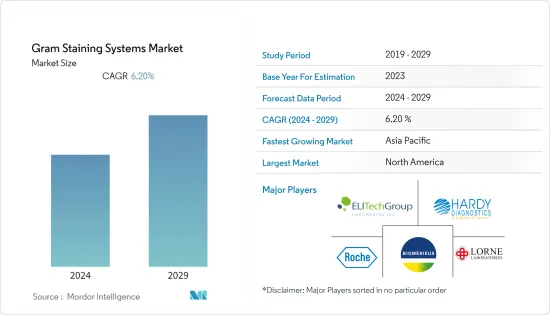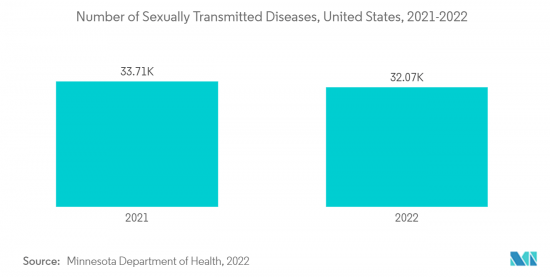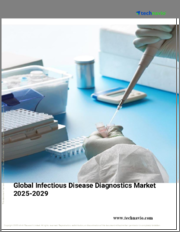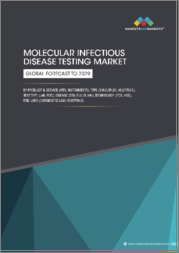
|
시장보고서
상품코드
1406027
그램 염색 시스템 : 시장 점유율 분석, 산업 동향과 통계, 성장 예측(2024-2029년)Gram Staining Systems - Market Share Analysis, Industry Trends & Statistics, Growth Forecasts 2024 - 2029 |
||||||
그램 염색 시스템 시장은 예측 기간(2024-2029년)에 CAGR 6.20%로 성장할 것으로 예측되고 있습니다.

주요 하이라이트
- COVID-19 팬데믹은 COVID-19 환자의 대량 유입으로 인한 전 세계 봉쇄와 검사 시설의 일부 또는 전체 폐쇄로 인해 그람 염색 시스템 시장에 큰 영향을 미쳤습니다.
- 예를 들어 미국 미생물학회의 2021년 1월 업데이트에 따르면 47.5%의 검사 시설이 일상적인 세균(연쇄상구균성 인두염, 폐렴, 기관지염, 요로감염 원인균 포함) 검출을 위한 장비가 부족한 것으로 나타났습니다. 따라서 COVID-19는 그람 염색 시스템 시장에 큰 영향을 미쳤습니다. 그러나 검사 서비스가 재개되고 COVID-19가 감소함에 따라 예측 기간 중 시장은 COVID-19 감소에서 회복될 것으로 예상됩니다.
- 시장 성장의 주요 요인은 전염병 증가로 인해 진단의 진보에 대한 요구가 증가하고 있기 때문입니다. 예를 들어 세계보건기구(WHO)가 발표한 'Global Tuberculosis Report 2022' 자료에 따르면 2021년 결핵 환자의 대부분은 WHO 지역의 동남아시아(45%), 아프리카(23%), 서태평양(18%), 동부 지중해(8.1%), 미주(2.9%), 유럽(2.2%)에서 발생할 것으로 예상됩니다.(2.9%), 유럽(2.2%)의 점유율은 작습니다. 따라서 결핵 환자의 유병률 증가는 결핵 감염 감지를위한 그람 염색에 대한 수요를 증가시켜 시장 성장을 가속할 것으로 예상됩니다.
- 또한 기술 발전과 임상 연구를 위한 연구비 증가는 시장 성장을 가속할 것으로 예상됩니다. 검사실에서는 자동 염색 시스템의 채택이 증가하고 있으며, 그 효율성과 정확성으로 인해 주목을 받고 있습니다. 예를 들어 2022년 12월 엘스비어(Elsevier)에 게재된 논문에 따르면 현미경 그램 염색 이미지의 분류를 위한 자동화 알고리즘의 가능성에 대한 유망한 결과를 보여주었습니다. 또한 다양한 그람 염색 기술을 활용한 임상 연구 증가는 시장 성장을 가속할 것으로 예상됩니다.
- 예를 들어 2023년 4월 소학대학교는 단쇄 및 중쇄에 배열된 그람양성 통성 혐기성 구균인 Enterococcus Spp의 표현형 및 유전자형 변이를 평가하는 임상시험을 후원했습니다. 이 때, 박테리아를 식별하기 위해 다양한 염색법이 사용됩니다. 따라서 이러한 임상 연구는 그람 염색 시약 및 시스템에 대한 수요를 증가시켜 시장 성장을 가속할 가능성이 높습니다.
- 이처럼 감염성 질환 증가, 기술 발전, 임상 연구를 위한 연구비 증가로 인해 조사 대상 시장은 예측 기간 중 큰 성장을 보일 것으로 예상됩니다. 그러나 염색 시스템에 대한 인식이 낮고 많은 사람들이 전통적인 방법으로 염색을 하는 것이 시장 성장을 제한하고 있습니다.
그램염색시스템 시장 동향
진단 실험실은 그람염색 시스템 시장에서 가장 빠르게 성장하는 최종사용자 부문
- 진단 실험실에서 그람염색은 세균 감염 여부를 신속하게 진단하는 데 도움이 되는 일반적인 검사입니다. 그람 염색은 응급 상황에서 임상 감염 환자를 치료하는 데 중요한 진단 툴입니다. 이 기술은 연조직 농양, 하기도 감염, 요로 감염, 자궁경부염, 요도염에서 중요합니다.
- 이 분야의 성장은 감염성 질환의 유병률 증가, 전통적인 수동 염색 절차에 비해 염색 시스템의 우월성, 임상 연구 분야에 대한 자금 지원 증가 등에 기인합니다. 예를 들어 2021년 8월에 업데이트된 유니세프 데이터에 따르면 전 세계에서 매년 아동 10만 명당 1,400건 이상, 아동 71명당 1건의 폐렴이 발생하고 있으며, 가장 높은 발병률은 남아시아(아동 10만 명당 2,500건)와 서중아프리카(아동 10만 명당 1,620건)에서 발생합니다. 1,620건)입니다. 객담 그램 염색은 폐렴을 검출하기 위해 객담 샘플에서 박테리아를 검출하는 검사입니다. 따라서 폐렴 환자가 증가함에 따라 그 진단에 대한 수요도 증가할 것으로 예상되며, 이는 예측 기간 중 시장 성장을 더욱 촉진할 것으로 예상됩니다.
- 또한 주요 기업의 제품 출시와 전략적 구상 증가는 이 부문의 성장을 가속할 것으로 예상됩니다. 예를 들어 2022년 10월 Lord's Mark Industries의 세계 헬스케어 부문인 LordsMed는 뭄바이 외곽 Vasai에 체외진단(IVD) 제조 시설을 설립했으며, 20,000평방피트 규모의 이 시설은 분석 장비, 임상 생화학, 혈액학, 혈청학, 면역학 시약 면역학 시약, 신속 검사 키트(ICMR 승인 항원 키트), 검사 소모품 등 체외진단(IVD) 및 현장 진단 솔루션을 생산하고 있습니다.
- 이러한 임상 생화학 검사 시약은 일반적으로 요로결석 감염(UTI), 폐렴 및 기타 세균 감염을 감지하는 데 사용되는 그람 염색 시약 및 소모품을 포함합니다.
- 따라서 감염성 질환 증가, 기술 발전, 임상 연구를 위한 연구비 증가로 인해 연구 부문은 예측 기간 중 큰 성장을 보일 것으로 예상됩니다.

예측 기간 중 북미가 시장에서 큰 비중을 차지할 것으로 예상
- 북미는 예측 기간 중 전체 시장에서 큰 비중을 차지할 것으로 예상됩니다. 높은 전염병 유병률과 잘 구축된 의료 인프라가 이 시장에서 큰 점유율을 차지하는 주요 요인 중 하나입니다.
- 예를 들어 성병 감시 2021에 따르면 2021년 미국에서 진단된 임질 사례는 710,151건으로 전년도 677,769건에서 증가했습니다. 임질은 그람 음성 감염에 속하고 그람 염색으로 진단 할 수 있으므로 임질 환자 증가는 그람 염색 시장을 밀어 붙일 가능성이 높습니다.
- 또한 정부의 유익한 노력과 제품 개선을 위한 자금 증가도 시장 성장을 가속하는 요인 중 하나입니다. 예를 들어 미국 국립보건원(NIH)의 2023년 3월 최신 정보에 따르면 미국에서는 2023년 폐렴 연구 및 관련 연구에 6억 9,000만 달러의 자금이 지원될 것으로 예상됩니다. 이처럼 다양한 감염성 질환의 진단 및 검사에 대한 자금 지원이 증가함에 따라 그람 염색에 대한 수요가 증가하여 예측 기간 중 시장 성장을 가속할 가능성이 높습니다.
- 또한 주요 기업의 진단 키트 출시 및 기타 전략적 활동 증가는 시장 성장을 가속할 것으로 예상됩니다. 예를 들어 2022년 6월 애질런트는 유럽연합(EU)에서 사용할 수 있는 체외진단의약품 규제(IVDR)를 준수하는 기기, 키트 및 시약을 발표했습니다. 이번 IVDR 준수 클래스 A 제품 출시로 진단 워크플로우에서 애질런트의 IVDR 기기, 키트 및 시약에 의존하는 EU내 실험실은 이러한 제품을 계속 사용할 수 있게 되었습니다. 이처럼 다양한 세균 감염을 검출하기 위한 IVD 시약의 출시는 예측 기간 중 그람염색 시장의 성장을 가속할 것으로 보입니다.
- 따라서 북미는 감염증 증가와 임상 연구를 위한 연구 자금 증가로 인해 예측 기간 중 큰 성장을 이룰 것으로 예상되고 있습니다.
그램 염색 시스템 산업 개요
그램 염색 시스템 시장은 경쟁이 치열하고 여러 주요 기업으로 구성되어 있습니다. 주요 기업은 제품 개발과 새로운 제조 시설 개설에 주력하고 있습니다. 현재 시장을 독점하고 있는 기업으로는 ELITechGroup, bioMerieux SA, Hardy Diagnostics, F. Hoffmann-La Roche Ltd, Lorne Laboratories Limited, Labema Oy, Thermo Fisher Scientific, Merck KGaA 등이 있습니다.
기타 특전
- 엑셀 형식의 시장 예측(ME) 시트
- 3개월간의 애널리스트 지원
목차
제1장 서론
- 조사의 전제조건과 시장 정의
- 조사 범위
제2장 조사 방법
제3장 주요 요약
제4장 시장 역학
- 시장 개요
- 시장 촉진요인
- 감염증 이환율의 상승
- 염색 시스템의 기술 진보 및 임상 연구 자금의 증가
- 시장 억제요인
- 시스템 인지도 부족
- Porter's Five Forces 분석
- 신규 진출업체의 위협
- 구매자/소비자의 교섭력
- 공급 기업의 교섭력
- 대체품의 위협
- 경쟁 기업간 경쟁 강도
제5장 시장 세분화(시장 규모, 금액 기반)
- 제품 유형별
- 염색 시스템
- 염색 시약
- 부속품
- 최종사용자별
- 진단 랩
- 병원
- 기타 최종사용자
- 지역별
- 북미
- 미국
- 캐나다
- 멕시코
- 유럽
- 독일
- 영국
- 프랑스
- 이탈리아
- 스페인
- 기타 유럽
- 아시아태평양
- 중국
- 일본
- 인도
- 호주
- 한국
- 기타 아시아태평양
- 중동 및 아프리카
- GCC
- 남아프리카공화국
- 기타 중동 및 아프리카
- 남미
- 브라질
- 아르헨티나
- 기타 남미
- 북미
제6장 경쟁 구도
- 기업 개요
- ELITechGroup
- bioMerieux SA
- Hardy Diagnostics
- F. Hoffmann-La Roche Ltd
- Lorne Laboratories Limited
- Labema Oy
- Thermo Fisher Scientific
- Merck KGaA
- MetaSystems
- Diagnostic BioSystems
제7장 시장 기회 및 향후 전망
KSA 24.01.22
The Gram Staining Systems Market is expected to register a CAGR of 6.20% during the forecast period(2024-2029).
Key Highlights
- The COVID-19 pandemic had a substantial influence on the gram staining systems market due to the global lockdown as well as the partial or complete shutdown of laboratory facilities due to the massive influx of COVID-19 patients.
- For instance, as per the January 2021 update by the American Society for Microbiology, 47.5% of labs had a shortage of supplies for the detection of routine bacteria (including the bacteria causing strep throat, pneumonia, bronchitis, and urinary tract infections). Hence, COVID-19 had a significant impact on the gram staining systems market. However, with the resumption of laboratory services and decreasing cases of COVID-19, the studied market is expected to recover from the reduction of COVID-19 over the forecast period.
- The major factor attributing to the growth of the market is the increasing need for advancements in diagnostics as there is an increasing prevalence of infectious diseases. For instance, according to the data published by the World Health Organization (WHO) in the Global Tuberculosis Report 2022, most TB cases in 2021 were in the WHO regions of South-East Asia (45%), Africa (23%), and Western Pacific (18%), with smaller shares in the Eastern Mediterranean (8.1%), the Americas (2.9%) and Europe (2.2%). Hence, the rise in the prevalence of TB cases is expected to increase the demand for gram staining for the detection of TB infections and thereby fuelling the market growth.
- Additionally, technological advancements and a rise in research funding for clinical research are expected to drive market growth. There is an increase in the adoption of automated staining systems in laboratories which gained a lot of attention due to their efficiency and accuracy. For instance, as per the article published in December 2022 in Elsevier, the research indicated promising results regarding the potential for an automated algorithm for the classification of microscopic gram stain images. Furthermore, a rise in clinical studies with the utilization of various gram-staining techniques is expected to drive market growth.
- For instance, in April 2023, Sohag University sponsored a clinical trial to evaluate phenotypic and genotypic variations of Enterococcus Spp, which are gram-positive facultative anaerobic cocci arranged in short and medium chains. During the procedure, various staining techniques are conducted to identify the bacteria. Thus, due to such clinical studies, the demand for gram-staining reagents and systems are likely to increase, thereby bolstering the market growth.
- Thus, due to the rise in infectious diseases, technological advancements, and a rise in research funding for clinical research, the studied market is anticipated to witness significant growth over the forecast period. However, lack of awareness of the staining systems and many using the conventional method for staining constraints the market growth.
Gram Staining Systems Market Trends
Diagnostic Laboratories is the Fastest Growing End User Segment in the Gram Staining Systems Market
- In diagnostic laboratories, gram stain is a common test that can help diagnose the presence of a bacterial infection quickly. Gram staining is an important tool in treating patients with clinical infections in the emergency important diagnostic tool in treating patients with clinical infections in the emergency. This technique is of importance in soft tissue abscesses, lower respiratory tract infections, urinary tract infections, cervicitis, and urethritis.
- The growth of the segment is attributed to the increasing prevalence of infectious diseases, the advantages of the staining systems over the manual conventional staining procedure, and the increased funding of the clinical research field. For instance, as per the UNICEF data updated in August 2021, globally, there were over 1,400 cases of pneumonia per 100,000 children, or 1 case per 71 children every year, with the greatest incidence occurring in South Asia (2,500 cases per 100,000 children) and West and Central Africa (1,620 cases per 100,000 children). A sputum gram stain is a laboratory test used to detect bacteria in a sputum sample for the detection of pneumonia. Thus, with the increasing cases of pneumonia, the demand for its diagnosis is also expected to increase, which is further expected to boost the growth of the market over the forecast period.
- Moreover, an increase in product launches and strategic initiatives by the key players are expected to drive segment growth. For instance, in October 2022, LordsMed, the global healthcare division of Lord's Mark Industries, launched an in-vitro diagnostics (IVD) manufacturing facility at Vasai, on the outskirts of Mumbai. The 20,000-sqft facility manufactures in vitro diagnostics (IVD) and point-of-care diagnostic solutions such as analyzers, reagents for clinical biochemistry, hematology, serology, immunology, rapid testing kits (ICMR-approved antigen kits), and lab consumables.
- Thus, the laboratory reagents for clinical biochemistry include gram-staining reagents and consumables, these are commonly used for the detection of urinary tarct infections (UTIs), pneumonia, and other bacterial infections, the studied market is expected to witness a significant market growth due to such expansions of manufacturing facilities.
- Hence, due to the rise in infectious diseases, technological advancements, and a rise in research funding for clinical research, the studied segment is anticipated to witness significant growth over the forecast period.

North America Anticipated to Hold a Significant Share in the Market Over the Forecast Period
- North America is expected to hold a significant market share in the overall market throughout the forecast period. The high prevalence of infectious diseases and the established healthcare infrastructure are some of the key factors accountable for its large share in the market.
- For instance, as per the Sexually Transmitted Disease Surveillance 2021, 710,151 cases of gonorrhea were diagnosed in the United States in 2021, which was an increase from 677,769 cases in the previous year. Thus, an increase in gonorrhea cases is likely to boost the gram staining market since gonorrhea comes under gram-negative infection, which can be diagnosed under gram staining.
- Furthermore, beneficial government initiatives and increased funding for product improvements are some of the drivers expected to increase market growth. For instance, as per the National Institute of Health (NIH) March 2023 update, USD 609 million is likely to be funded for pneumonia research and related studies in 2023 in the United States. Thus, such an increase in funding for the diagnosis and testing of various infectious diseases is likely to increase the demand for gram staining and thereby drive the market growth over the forecast period.
- Furthermore, an increase in diagnostic kit launches and other strategic activities by the key players is expected to bolster market growth. For instance, in June 2022, Agilent released in vitro diagnostic regulation (IVDR)--compliant instruments, kits, and reagents for use in the European Union (EU). This launch of IVDR-compliant Class A products ensures that labs in the EU that rely on Agilent IVDR instruments, kits, and reagents in their diagnostic workflows will continue to be able to use these products without disruption. Thus, such IVD reagent launches for the detection of various bacterial infections bolster the gram staining market growth over the forecast period.
- Therefore, due to the rise in infectious diseases and a rise in research funding for clinical research, North America is anticipated to witness significant growth over the forecast period.
Gram Staining Systems Industry Overview
The gram staining systems market is competitive and consists of several major players. The major players are focusing on product development and the opening of new manufacturing facilities. Some of the companies which are currently dominating the market are ELITechGroup, bioMerieux SA, Hardy Diagnostics, F. Hoffmann-La Roche Ltd, Lorne Laboratories Limited, Labema Oy, Thermo Fisher Scientific, Merck KGaA.
Additional Benefits:
- The market estimate (ME) sheet in Excel format
- 3 months of analyst support
TABLE OF CONTENTS
1 INTRODUCTION
- 1.1 Study Assumptions and Market Definition
- 1.2 Scope of the Study
2 RESEARCH METHODOLOGY
3 EXECUTIVE SUMMARY
4 MARKET DYNAMICS
- 4.1 Market Overview
- 4.2 Market Drivers
- 4.2.1 Rise in Prevalence of Infectious Diseases
- 4.2.2 Technological Advancements in Staining Systems and Increase in Funding for Clinical Research
- 4.3 Market Restraints
- 4.3.1 Lack of Awareness of the Systems
- 4.4 Porter's Five Forces Analysis
- 4.4.1 Threat of New Entrants
- 4.4.2 Bargaining Power of Buyers/Consumers
- 4.4.3 Bargaining Power of Suppliers
- 4.4.4 Threat of Substitute Products
- 4.4.5 Intensity of Competitive Rivalry
5 MARKET SEGMENTATION (Market Size by Value - USD)
- 5.1 By Product Type
- 5.1.1 Staining Systems
- 5.1.2 Staining Reagents
- 5.1.3 Accessories
- 5.2 By End-User
- 5.2.1 Diagnostic Laboratories
- 5.2.2 Hospitals
- 5.2.3 Other End-Users
- 5.3 Geography
- 5.3.1 North America
- 5.3.1.1 United States
- 5.3.1.2 Canada
- 5.3.1.3 Mexico
- 5.3.2 Europe
- 5.3.2.1 Germany
- 5.3.2.2 United Kingdom
- 5.3.2.3 France
- 5.3.2.4 Italy
- 5.3.2.5 Spain
- 5.3.2.6 Rest of Europe
- 5.3.3 Asia-Pacific
- 5.3.3.1 China
- 5.3.3.2 Japan
- 5.3.3.3 India
- 5.3.3.4 Australia
- 5.3.3.5 South Korea
- 5.3.3.6 Rest of Asia-Pacific
- 5.3.4 Middle East and Africa
- 5.3.4.1 GCC
- 5.3.4.2 South Africa
- 5.3.4.3 Rest of Middle East and Africa
- 5.3.5 South America
- 5.3.5.1 Brazil
- 5.3.5.2 Argentina
- 5.3.5.3 Rest of South America
- 5.3.1 North America
6 COMPETITIVE LANDSCAPE
- 6.1 Company Profiles
- 6.1.1 ELITechGroup
- 6.1.2 bioMerieux SA
- 6.1.3 Hardy Diagnostics
- 6.1.4 F. Hoffmann-La Roche Ltd
- 6.1.5 Lorne Laboratories Limited
- 6.1.6 Labema Oy
- 6.1.7 Thermo Fisher Scientific
- 6.1.8 Merck KGaA
- 6.1.9 MetaSystems
- 6.1.10 Diagnostic BioSystems

















